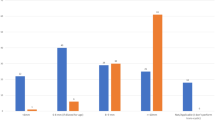Abstract
Background
Variation exists in the management of choledocholithiasis (CDL). This study evaluated associations between demographic and practice-related characteristics and CDL management.
Methods
A 22-item, web-based survey was administered to US general surgeons. Respondents were classified into metropolitan or nonmetropolitan groups by zip code. Univariate tests and multivariable logistic regression were used to determine factors associated with CDL management preferences.
Results
The survey was sent to 32,932 surgeons; 9902 performed laparoscopic cholecystectomy within the last year; 750 of 771 respondents had a valid US zip code and were included in the analysis. Mean practice time was 18 ± 10 years, 87 % were male, and 83 % practiced in a metropolitan area. For preoperatively known CDL, 86 % chose preoperative endoscopic retrograde cholangiopancreatography (ERCP). Those in metropolitan areas were more likely to select preoperative ERCP than those in nonmetropolitan areas (88 vs. 79 %, p < 0.001). For CDL discovered intraoperatively, 30 % selected laparoscopic common bile duct exploration (LCBDE) as their preferred method of management with no difference between metropolitan and nonmetropolitan areas (30 vs. 26 %, p = 0.335). The top reasons for not performing LCBDE were: having a reliable ERCP proceduralist available, lack of equipment, and lack of comfort performing LCBDE. Factors associated with preoperative ERCP were: metropolitan status, selective intraoperative cholangiography (IOC), and availability of a reliable ERCP proceduralist. Those who perform selective IOC were 70 % less likely to prefer LCBDE (OR 0.32, 95 % CI 0.18–0.57, p < 0.001). Those with a reliable ERCP proceduralist available were 90 % less likely to prefer LCBDE (OR 0.10, 95 % CI 0.04–0.26, p < 0.001).
Conclusions
The majority of respondents preferred ERCP for the management of CDL. Having a reliable ERCP proceduralist available, use of selective IOC, and metropolitan status were independently associated with preoperative ERCP. Postoperative ERCP was preferred for managing intraoperatively discovered CDL. Many surgeons are uncomfortable performing LCBDE, and increased training may be needed.









Similar content being viewed by others
References
Shelton J, Kummerow K, Phillips S, Griffin M, Holzman MD, Nealon W, Pinson CW, Poulose BK (2012) An urban-rural blight? Choledocholithiasis presentation and treatment. J Surg Res 173:193–197
Harris PA, Taylor R, Thielke R, Payne J, Gonzalez N, Conde JG (2009) Research electronic data capture (REDCap)–a metadata-driven methodology and workflow process for providing translational research informatics support. J Biomed Inform 42:377–381
Chokshi NK, Simeone DM, Chari RS, Dorey F, Guner YS, Upperman JS (2009) A survey of academic surgeons: work, stress, and research. Surgery 146:462–468
Cothren CC, Moore EE, Hoyt DB (2008) The US trauma surgeon’s current scope of practice: can we deliver acute care surgery? J Trauma 64: 955–965; discussion 965–958
King J, Fraher EP, Ricketts TC, Charles A, Sheldon GF, Meyer AA (2009) Characteristics of practice among rural and urban general surgeons in North Carolina. Ann Surg 249:1052–1060
Bingener J, Schwesinger WH (2006) Management of common bile duct stones in a rural area of the United States: results of a survey. Surg Endosc 20:577–579
Poulose BK, Speroff T, Holzman MD (2007) Optimizing choledocholithiasis management: a cost-effectiveness analysis. Arch Surg 142: 43–48; discussion 49
Chang L, Lo S, Stabile BE, Lewis RJ, Toosie K, de Virgilio C (2000) Preoperative versus postoperative endoscopic retrograde cholangiopancreatography in mild to moderate gallstone pancreatitis: a prospective randomized trial. Ann Surg 231:82–87
Wang B, Guo Z, Liu Z, Wang Y, Si Y, Zhu Y, Jin M (2013) Preoperative versus intraoperative endoscopic sphincterotomy in patients with gallbladder and suspected common bile duct stones: system review and meta-analysis. Surg Endosc 27:2454–2465
Freeman ML, Guda NM (2005) ERCP cannulation: a review of reported techniques. Gastrointest Endosc 61:112–125
Iranmanesh P, Frossard JL, Mugnier-Konrad B, Morel P, Majno P, Nguyen-Tang T, Berney T, Mentha G, Toso C (2014) Initial cholecystectomy vs sequential common duct endoscopic assessment and subsequent cholecystectomy for suspected gallstone migration: a randomized clinical trial. JAMA 312:137–144
Martin DJ, Vernon DR, Toouli J (2006) Surgical versus endoscopic treatment of bile duct stones. Cochrane Database Syst Rev CD003327
Kharbutli B, Velanovich V (2008) Management of preoperatively suspected choledocholithiasis: a decision analysis. J Gastrointest Surg 12:1973–1980
Overby DW, Apelgren KN, Richardson W, Fanelli R, SoAGaE Surgeons (2010) SAGES guidelines for the clinical application of laparoscopic biliary tract surgery. Surg Endosc 24:2368–2386
Poulose BK, Phillips S, Nealon W, Shelton J, Kummerow K, Penson D, Holzman MD (2011) Choledocholithiasis management in rural America: health disparity or health opportunity? J Surg Res 170:214–219
Doty B, Zuckerman R, Borgstrom D (2009) Are general surgery residency programs likely to prepare future rural surgeons? J Surg Educ 66:74–79
Doty B, Zuckerman R (2009) Rural surgery: framing the issues. Surg Clin North Am 89:1279–1284 (vii)
Paganini AM, Guerrieri M, Sarnari J, De Sanctis A, D’Ambrosio G, Lezoche G, Perretta S, Lezoche E (2007) Thirteen years’ experience with laparoscopic transcystic common bile duct exploration for stones. Effectiveness and long-term results. Surg Endosc 21:34–40
Acknowledgments
This research was supported by a Society of American Gastrointestinal and Endoscopic Surgeons research award.
Disclosures
Dr. Poulose has received research support from Bard Davol and serves as a consultant for Ariste Medical. Drs. Baucom, Feurer, Shelton, Kummerow, and Holzman have no conflicts of interest or financial ties to disclose.
Author information
Authors and Affiliations
Corresponding author
Rights and permissions
About this article
Cite this article
Baucom, R.B., Feurer, I.D., Shelton, J.S. et al. Surgeons, ERCP, and laparoscopic common bile duct exploration: do we need a standard approach for common bile duct stones?. Surg Endosc 30, 414–423 (2016). https://doi.org/10.1007/s00464-015-4273-z
Received:
Accepted:
Published:
Issue Date:
DOI: https://doi.org/10.1007/s00464-015-4273-z




